Learn how to make a framboisier cake, a twist on the classic French layer cake called fraisier. The fraisier is two layers of sponge cake filled with mousseline cream and fresh strawberries, while the framboisier is made with fresh raspberries. The cake is traditionally topped with marzipan, dyed a lovely shade of pastel pink, though sometimes it is simply topped with a generous sprinkling of powdered sugar.

Fraisier and framboisier cakes are my favourite type of cake. Growing up, tthey are THE cake we would get from the French bakeries to celebrate an occasion.
Jump to:
Where it gets its name from
The framboisier cake is the raspberry variation of the fraisier cake, a traditional French layer cake made with strawberries. The fraisier is named after the French word for strawberry, which is "fraise." Similarly, the framboisier is named after the word "framboise," which is the French word for raspberry.
This French dessert is designed to showcase summer's most popular berry because the sides of this layer cake are not frosted, allowing you to see the strawberries that are layered inside.
Framboisier is also the French word for a raspberry bush, as the word fraisier can also refer to a strawberry plant. So, if you look up either of these words, you might get mixed results, some articles about gardening and others about baking!
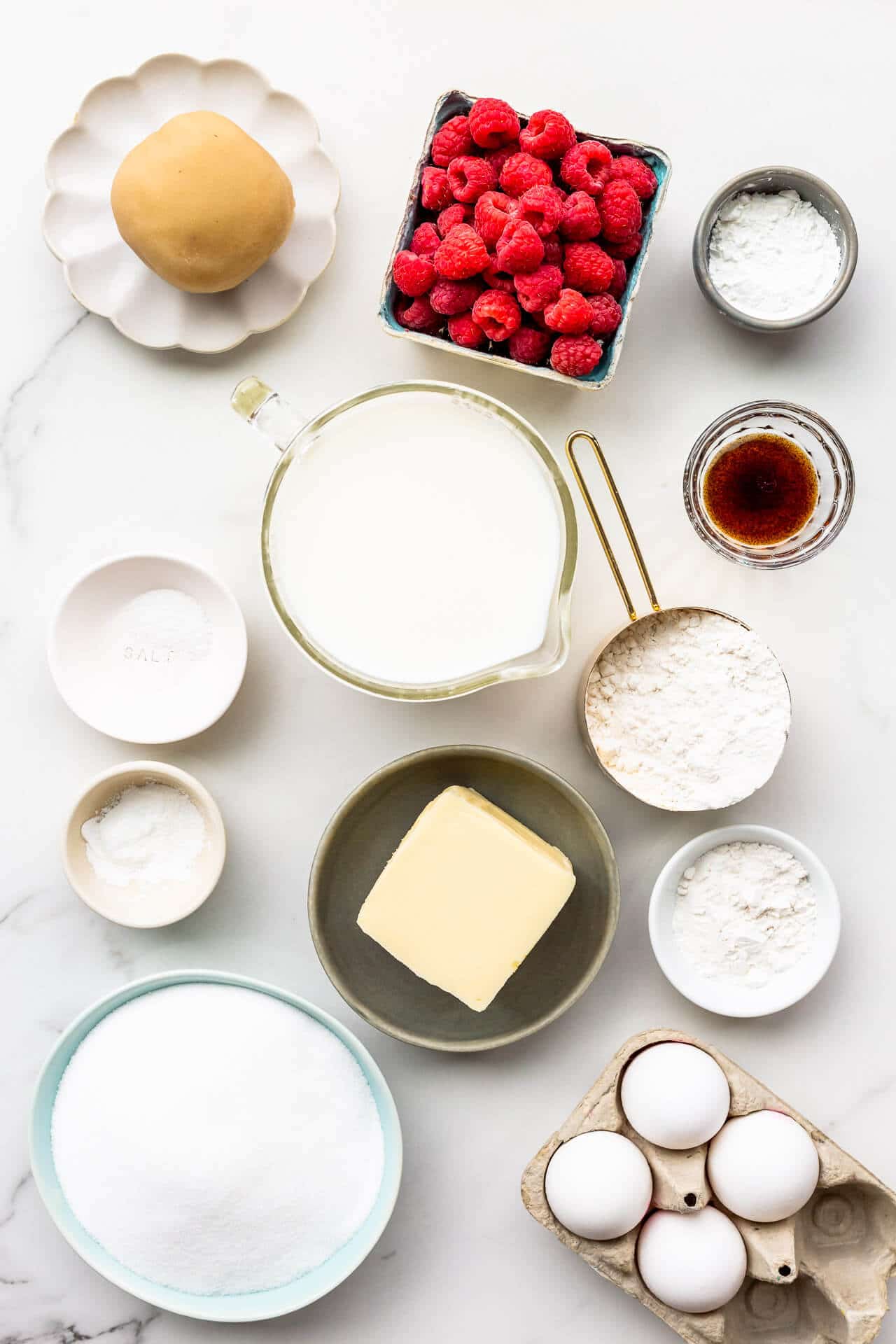
Components of framboisier and fraisier cakes
The fraisier is made from two layers of sponge cake (often thin layers of génoise), brushed with a simple syrup, and filled with mousseline cream and fresh strawberries, while the framboisier cake is made with raspberries. Both are topped with either a dusting of powdered sugar or with a thin layer of marzipan.
Technically, to make this cake, you can actually use any berry you'd like, really, but I much prefer to use raspberries because the tart flavour cuts through the buttery sweetness of the vanilla mousseline cream.
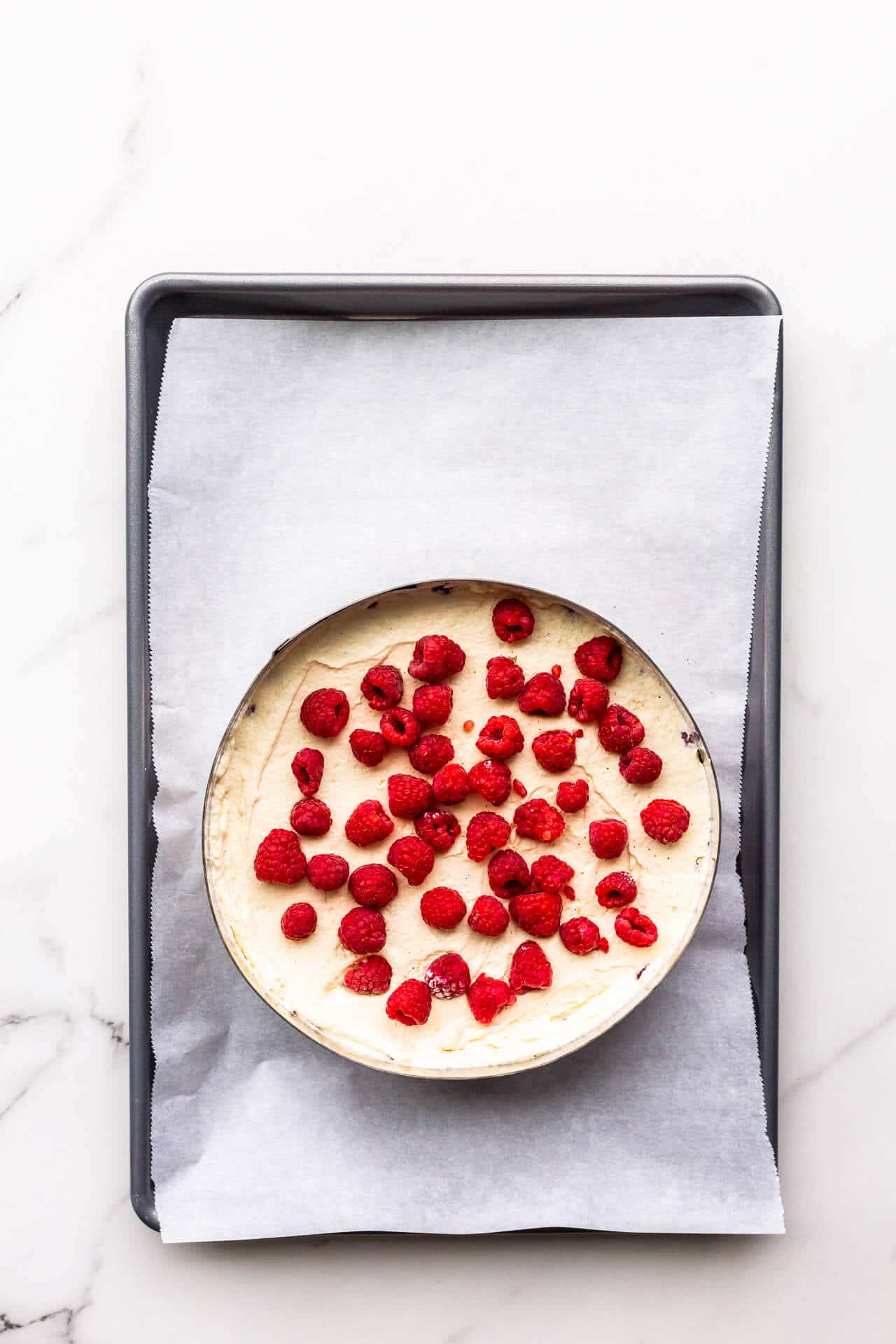
To make a framboisier (or a fraisier), you will need:
- two layers of sponge cake or vanilla cake (traditionally, the recipe would be made with a génoise or even a biscuit joconde)—I like to use a hot milk cake because it's easy!
- soaking syrup that is made from 2 parts water and 1 part granulated sugar, by weight—you can leave the syrup plain or flavour it with a little spiced rum, Chambord, or another sweet fruity liqueur.
- vanilla mousseline cream, which is a French baking term for a filling made from pastry cream lightened with butter—alternatives for it include Italian meringue buttercream or a diplomat cream, which is a pastry cream lightened with whipped cream and stabilized with gelatin
- fresh raspberries if you are making a framboisier (or strawberries if you are making a fraisier)
- marzipan or icing sugar (I like to use German marzipan that is clearly labelled with the quantity of almonds so that you know you are using the good kind)

Special equipment to make framboisier and fraisier cakes
The beauty of framboisier and fraisier cakes is that they are "naked cakes" with unfrosted sides that reveal the layering. To create the neatest naked cakes, without any stress, you will need to invest in a few special tools:
- cake ring—I use 6-inch cake rings for the Milk Bar cakes and for framboisier cakes and fraisiers, I like to make them in 8-inch cake rings (which you can buy on Amazon).
- acetate—the cake ring is lined with acetate to make unmoulding easy and completely stress-free. The acetate prevents the cake from sticking to the mould and it also creates a perfect, smooth edge. You can buy it from specialty baking stores or order a roll from Amazon).
Using a cake ring and acetate allows you to build a "naked" cake with perfectly smooth, straight edges. It's the same technique that is used for the Milk Bar recipes, like the Milk Bar birthday cake, the blackberry almond cake, and the banana split cake.

How to make it
The beauty of fraisier and framboisier cakes is that the edges of the layer cake are not frosted. The cut berries are lined up all the way around the edge of the cake to feature them, otherwise, the mousseline cream would hide them.
Sponge cake for layering
A classic génoise cake works perfectly well here, but I'm a big fan of the hot milk cake, which is what we use for most of our summer cakes and desserts, like berry trifle.
The hot milk cake is lighter than a génoise because it's leavened with both whipped eggs and baking powder. It's also more tender because of. the higher sugar content in the cake batter and the milk, which yields a softer cake with a more open crumb.
Tip: Don't confuse baking soda and baking powder in this recipe. If you are unsure, read this comparison of baking soda versus baking powder.

Basic soaking syrup for cakes
Layer cakes made from sponge cakes often feature a soaking syrup or a simple syrup made from water and sugar (in a 2:1 ratio, by weight). The liquid is brushed onto each layer of cake, sometimes on both sides, to lock in moisture and to add a little flavour. Of course, you don't have to add alcohol to the syrup.
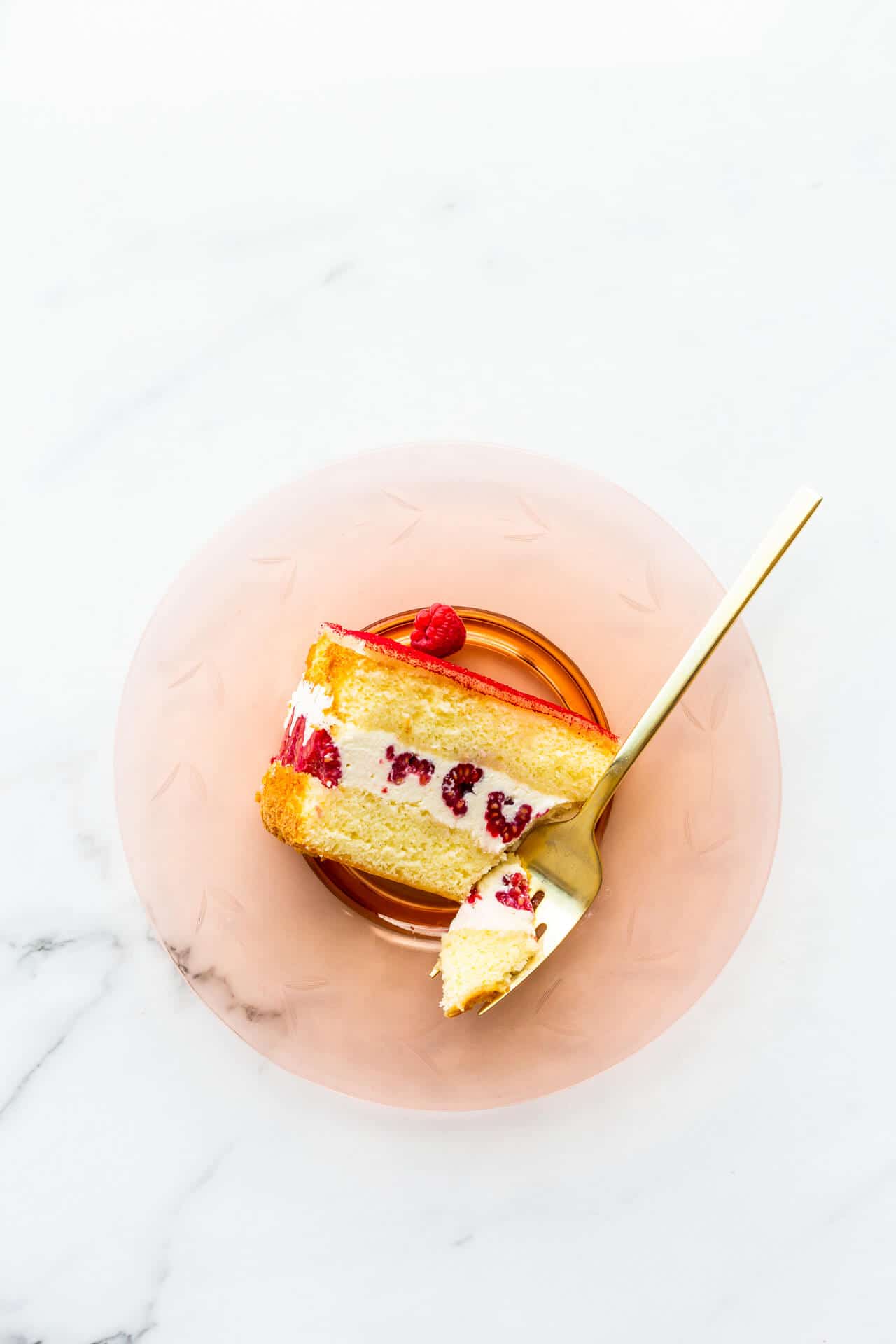
Mousseline cream filling
Mousseline cream is pastry cream that is whipped with lots of butter. Ironically, the extra butter gives this filling a lighter texture than straight pastry cream!
In order to successfully make a mousseline cream, like with other real buttercreams, it's important that the butter and the pastry cream are similar temperatures:
- If the pastry cream is too cold (like if you chilled it in the refrigerator for hours), the softened butter will harden as you whip the two together. This lead to a grainy frosting with tiny chunks of butter.
- To fix this, you will have to warm the mixing bowl with a hair dryer or a heat gun to warm the filling and whip the mixture a lot.
- If the butter is too warm (and if your kitchen is too warm), the emulsion in the filling will break, and the fat may separate out of the filling, leading to an overly shiny, greasy texture.
- To fix this, you may have to chill the filling in the refrigerator for 20–30 minutes to cool it down and then whip the mixture a lot.
Either way, the filling does need to be whipped/whisked a lot in order to emulsify it and also to achieve a lighter, more airy texture and taste.

Marzipan to garnish layer cakes
You can colour some marzipan to a pastel pink with some food dye, kneading marzipan and working the colour in by hand. I prefer to leave the marzipan uncoloured, and then to sprinkle the top of the cake with freeze-dried raspberry (or strawberry) powder to add a pop of colour. You can use a mini strainer to evenly sprinkle the ground berries on top.
The key to the marzipan layer is to roll it out and cut it to exactly the size of the cake. In fact, you can use the cake ring you build the cake in as a giant cutter for the marzipan layer. Just make sure to do this step before you start building the layer cake!
As you can see, the fraisier and framboisier cakes are the French equivalent of the Victoria sponge cake recipe, which is a British layer cake made from two layers of sponge cake, filled with whipped cream, jam, and fresh berries.

How to store this cake
Given this raspberry cake is made with fresh berries and a mousseline cream, it's best to store it in the fridge. If you've cut into the cake, just cover the cut edges with pieces of parchment to prevent them from drying out. Place the cake in the fridge until the frosting is firm and cold, then cover the whole thing loosely with aluminum foil. You can store this cake for up to a week, or freeze slices for later. The berries will break down if you defrost this cake, so it's best stored in the fridge and eaten within a week.
For a detailed explanation, read about how to store cake.
Here is my recipe to make a framboisier. The recipe may seem overwhelming and has a lot of components, but you can actually make it in an afternoon, so don't panic! This cake is worth the time spent!
📖 Recipe
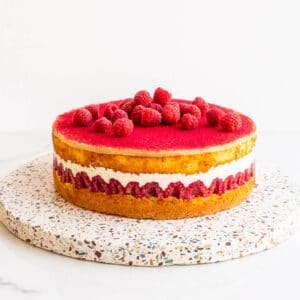
Framboisier Cake
Ingredients
Vanilla bean pastry cream
- 500 mL whole milk (3.25 % fat) or low-fat milk
- 100 grams granulated sugar divided
- 2 large egg(s)
- 24 grams bleached all-purpose flour
- 16 grams cornstarch
- 1.25 mL Diamond Crystal fine kosher salt
- 5 mL vanilla bean paste
Hot milk sponge cake
- 125 mL whole milk (3.25 % fat) skim milk or low-fat milk will also work here
- 15 grams unsalted butter
- 5 mL pure vanilla extract
- 125 grams bleached all-purpose flour
- 5 mL baking powder
- 1.25 mL Diamond Crystal fine kosher salt
- 2 large egg(s)
- 200 grams granulated sugar
Syrup
- 100 mL water
- 50 grams granulated sugar
- 15 mL spiced or dark rum
Mousseline cream
- 1 batch vanilla bean pastry cream recipe above
- 230 grams unsalted butter room temperature (softened)
- 5 mL pure vanilla extract
Framboisier assembly
- 300 grams Fresh raspberries
- 200 grams marzipan rolled out and trimmed into an 8-inch circle
- freeze-dried rapsberries
Instructions
Pastry cream
- Place a strainer over a large bowl. Set aside.
- Place the milk in a medium saucepan. Stir in half the sugar. Heat over medium–high until the milk is almost boiliing.
- Meanwhile whip the eggs with the rest of the sugar until lightened in colour. Whisk in the flour, cornstarch, and vanilla bean paste until smooth.
- When the milk is hot, turn off the stove and pour the milk over the egg mixture and whisk well to properly incorporate all the ingredients.
- Pour the mixture back into the saucepan and heat on medium heat until the mixture comes to a boil, whisking constantly.
- Boil the mixture for 2 minutes until very thick, then immediately take off the heat and pour the custard over the strainer and push it through.
- Cover the pastry cream with plastic wrap and let cool to room temperature.
Hot milk sponge cake
- Preheat the oven to 350 °F (175 °C). Butter and flour an 8-inch (20 cm) cake pan with 2-inch (5 cm) sides or an 8-inch (20 cm) springform. Line the bottom with parchment paper. Set aside.
- In a small saucepan (or in a microwave safe bowl), heat the milk with the butter until the butter is melted on low heat. Add the vanilla and let cool slightly.
- Sift the flour with the baking powder and salt into a medium bowl. Set aside.
- In the bowl of an electric mixer fitted with the whisk attachment, whip the eggs with the sugar until very light and fluffy. The mixture should at least double in volume, if not more.
- Add dry ingredients alternately with wet ingredients, beginning and ending with the dry.
- Transfer the batter to the prepared cake pan and smooth it out. Tap the cake pan on the counter a few times to release any big air bubbles.
- Bake the cake until golden brown. A cake tester inserted into the middle should come out clean. The cake will be spongy and light and spring back when gently pressed. This takes about 35 minutes.
- Let cool slightly before unmoulding onto a wire rack to cool completely. You can cool the cake upside down to flatten the top.
Syrup
- In a small saucepan, combine the water and the sugar. Heat it on medium until the sugar is dissolved.
- Remove from the heat and add the rum. Let cool.
Mousseline
- In the bowl of a stand mixer fitted with the whisk attachment, whip the room temperature pastry cream to loosen it up.
- Add the soft butter, a piece at a time, mixing well between each addition.
- Add the vanilla extract. Whip the mixture until it is light and fluffy.
- Transfer the mousseline to a large pastry bag and use immediately.
Framboisier assembly
- Using a serrated knife, trim the top of the sponge cake if necessary so that it is flat and levelled.
- Slice the sponge cake into two equal layers.
- Place the bottom layer on the bottom of the ring and press it gently so that it fits flat.
- Brush the cake with one third of the syrup, roughly 50 mL (a little more than 3 tbsp).
- Slice 13 to 14 raspberries in half and arrange them neatly on top of the bottom layer of cake, pressing them gently against the acetate to set them in place.
- Pipe half the mousseline in the middle and smooth it from edge to edge, gently pushing it against the berries to lock them in place.
- Scatter raspberries over the mousseline (you'll need 50 to 60 berries depending on their size). Press the berries into the cream, gently.
- Pipe the rest of the mousseline over the berries, then smooth it from edge to edge with an offset spatula. The berries should be completely covered.
- Brush the underside of the top cake layer with 50 mL of syrup, then place over the mousseline cream, pressing gently to make sure there are no gaps of air.
- Brush the top of the cake with the rest of the syrup.
- Place the marzipan on top and press it gently to smooth it out.
- Chill the cake in the fridge for at least 4 hours.
- Before serving, remove the cake ring and gently peel off the acetate.
- Let the cake sit at room temperature for 30 minutes so that the mousseline isn't too cold.
Notes
- When adding the wet and the dry alternately, remember to start and end with the dry. Thus: dry, wet, dry, wet, dry. This is one of the golden rules of baking, although I’m not quite sure why.
- We always butter (or spray with cooking spray) the inside of the pan and coat it with sugar (not flour) because sugar is delicious. Flour works best to prevent sticking.
- The 35-minute baking time is pretty exact. Normally, my mom and her mom would bake this in a tube pan (angel food cake pan). It always takes exactly 35 minutes for the cake to bake. No joke. This time, I chose to deviate from the tradition, and I baked it in a loaf pan. And, once again, it came out perfectly! The only difference was that it baked for 47 minutes. Now, I’ve only baked it once in the loaf pan, so I cannot say for sure that it will take you 47 minutes. So start checking it after 45 minutes, or when you notice the edges coming away from the sides.
Nutrition


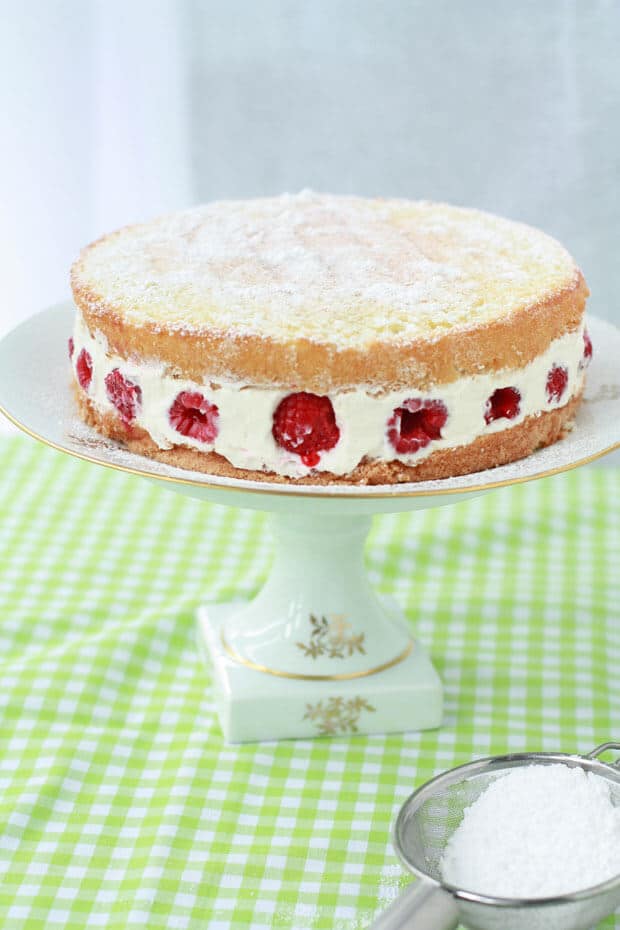

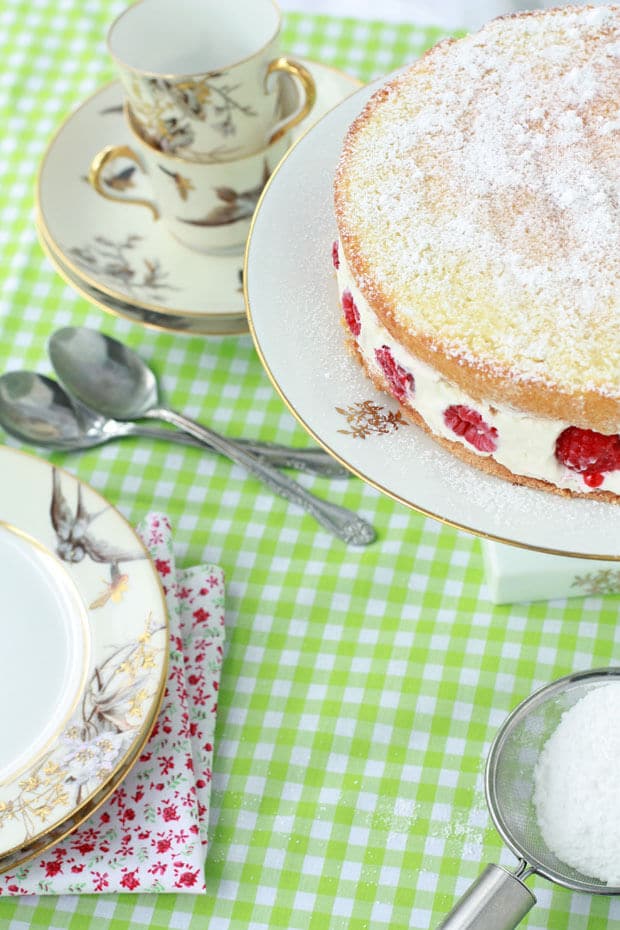









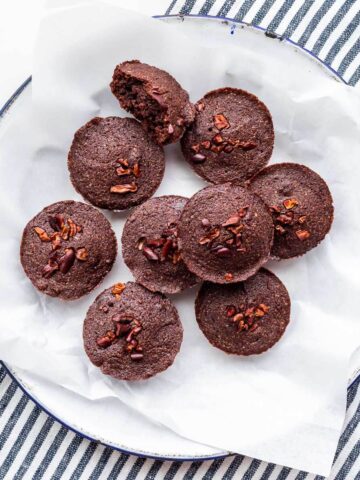



Cyndi says
When and where do you add the vanilla bean pastry cream?
Janice says
Hi Cyndi,
You make the mousseline from pastry cream plus butter, so the vanilla bean pastry cream you make at the beginning of the recipe is used later in the steps to make the mousseline. I hope that helps! I apologize for the confusion!